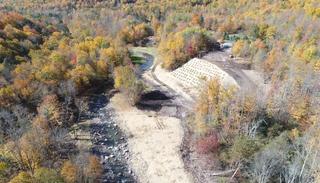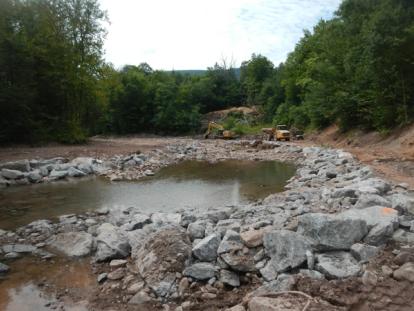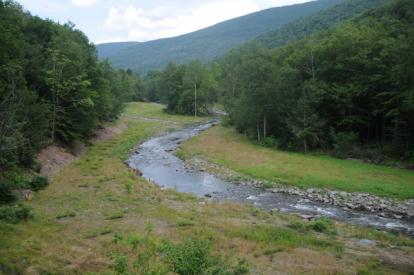Stony Clove Creek stream turbidity reduction
- Client Name
- Ashokan Watershed Stream Management Program
- Location
- Lanesville, New York, USA
- Water resources engineering

This project received the 2024 Platinum Engineering Excellence Award in Water Resources from the American Council of Engineering Companies of New York (ACEC NY)
Challenge
The Stony Clove Creek watershed is the largest tributary subbasin to the upper Esopus Creek, which supplies water to the Ashokan Reservoir, one of the largest in the New York City water supply system. This watershed is known to be a major contributor of suspended sediments to Esopus Creek, with detrimental water quality impacts to this critical unfiltered water supply.
One location along the Stony Clove Creek watershed had been the subject of ongoing observation as a Bank Erosion Monitoring Study site. The stream experienced an avulsion (a sudden separation of the riverbank) at this site during flooding caused by Tropical Storm Irene in August 2011, which instigated a mass bank failure and deposited significant suspended sediment into the water supply. The site continued to evolve and show additional risk markers, most notably in December 2020, where a rotational failure along the eroding bank was identified as a new hazard that could significantly impact water quality.
Stony Clove Creek Pre-Construction Conditions
Increasing detriment to water quality resulting from bed and bank erosion during high flow events (similar to the avulsion experienced in 2011) were estimated to increase as the number and intensity of severe weather occurrences continued to rise in the area due to climate change. The social and economic impact of doing nothing was not acceptable within this critical drinking water supply system.
Solution
The Ashokan Watershed Steam Management Program, in conjunction with the Ulster County Soil and Water Conservation District and the New York City Department of Environmental Protection chose SLR to design a stream turbidity solution to protect the water quality in the area by correcting the vertically unstable stream and prevent further turbidity production. SLR’s unique set of multi-disciplinary expertise in hydrology, geotechnical engineering, civil engineering, construction engineering, water resource engineering, and environmental management, permitting and compliance played a key role in the selection of the firm.
The project involved heavy consideration and analysis of extremely dynamic morphological processes at work in the semi-alluvial basin. Restoration design focused on addressing the conditions that contributed suspended sediments to the stream with minimal unnecessary disruption of the stream's natural geomorphological processes in the valley.
Innovative, Resilient and Sustainable Design Solution
SLR’s approach to the Stony Clove Creek watershed focused on evaluating and addressing a wide range of physical and environmental constraints and influences to develop a resilient and sustainable design solution. A unique and innovative combination of evaluation and design techniques was incorporated, which included: protection and stabilization of steep slopes; installation of boulder grade control structures; channel banks including a combination of bioengineering methods and robust armoring; a riffle-pool channel; in-stream structures to provide channel diversity; incorporation of live-staked boulder and rootwad revetments; and integration of bioengineering methods.
Impact
The entire restoration project covered approximately 1,500 linear feet of the stream corridor and included the stream channel, floodplains, and riparian areas, encompassing a total of approximately 6.6 acres. The constructed project captured all the main elements and has thus far proved successful in the reduction of stream turbidity, in the creation of aquatic habitat, and in the revegetation of native species.
The clients are extremely pleased with the conduct and performance of SLR on the project.
“We compliment SLR for their professionalism, multi-disciplinary expertise, application of unique and effective solutions, and dedication to this project. We are all extremely proud of this important project and look forward to working with SLR on future projects.”
David Warne, Assistant Commissioner, Watershed Protection Programs, New York City Department of Environmental Protection




